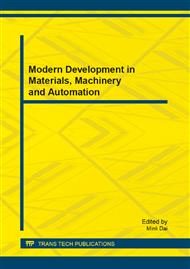[1]
Zhenyu Lu, Yongmin Lin, Shuang Zhao, Xuebin Chen. Study on feature selection and weighting based on synonym merge in text categorization: the second International Conference on Future Networks. (2010): 105-109.
DOI: 10.1109/icfn.2010.70
Google Scholar
[2]
Roberto Navigli, Stefano Faralli: Two Birds with One Stone: Learning Semantic Models for Text Categorization and Word Sense Disambiguation. International Conference on Information and Knowledge Management, Proceedings, pp.2317-2320.
DOI: 10.1145/2063576.2063955
Google Scholar
[3]
Lan, M. et al., 2009. Supervised and traditional term weighting methods for automatic text categorization. IEEE Trans. Pattern Anal. Machine Intell. 31(4): 721-735.
DOI: 10.1109/tpami.2008.110
Google Scholar
[4]
Tong, Yala, Wang, ChunZhi, 2009. Dimensionality reduction in webpage categorization using probabilistic latent semantic analysis and adaptive general particle swarm optimization. In: 2009 International Workshop on Intelligent Systems and Applications.
DOI: 10.1109/iwisa.2009.5072835
Google Scholar
[5]
Xue, Xiaobing, Zhou, Zhihua, 2009. Distributional features for text categorization. Trans. Knowl. Data Eng. 21(3): 428-441.
DOI: 10.1109/tkde.2008.166
Google Scholar
[6]
Li Zhixing, Xiong Zhongyang, Zhang Yufang, Liu Chunyong, Li Kuan. Fast text categorization using concise semantic analysis. Pattern Recognition Letters 32 (2011): 441-448.
DOI: 10.1016/j.patrec.2010.11.001
Google Scholar
[7]
Gabrilovich, E., Markovitch, S., 2009. Wikipedia-based semantic interpretation for natural language processing. J. Artif. Intell. Res. 34, 443-498.
DOI: 10.1613/jair.2669
Google Scholar
[8]
Information on http: /www. keenage. com.
Google Scholar
[9]
G. Miller, R. Beckwith, C. Felbaum, Introduction to wordnet: an online lexical database, (1933).
Google Scholar
[10]
Jamal Abdul Nasir, Asim Karim, George Tsatsaronis, and Iraklis Varlamis. A knowledge-based semantic kernel for text classification. SPIRE 2011, LNCS 7024, pp.261-266.
DOI: 10.1007/978-3-642-24583-1_25
Google Scholar
[11]
Liu Q., Li S., Based on the HowNet vocabulary semantic similarity calculation,. Computational Linguistics and Chinese Language Processing, (2002).
Google Scholar
[12]
Yang, Y., Liu, X., 1999. A re-examination of text categorization methods. In: Annual ACM Conference on Research and Development in Information Retrieval, pp.42-49.
DOI: 10.1145/312624.312647
Google Scholar
[13]
Wenqian Shang, Houkuan Huang, Haibin Zhu, et al. A novel feature selection algorithm for text categorization. Expert Systems with Applications 33(2007): 1-5.
DOI: 10.1016/j.eswa.2006.04.001
Google Scholar


